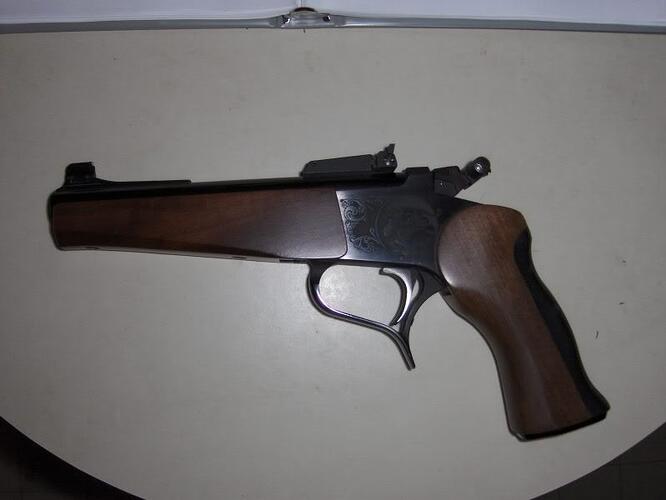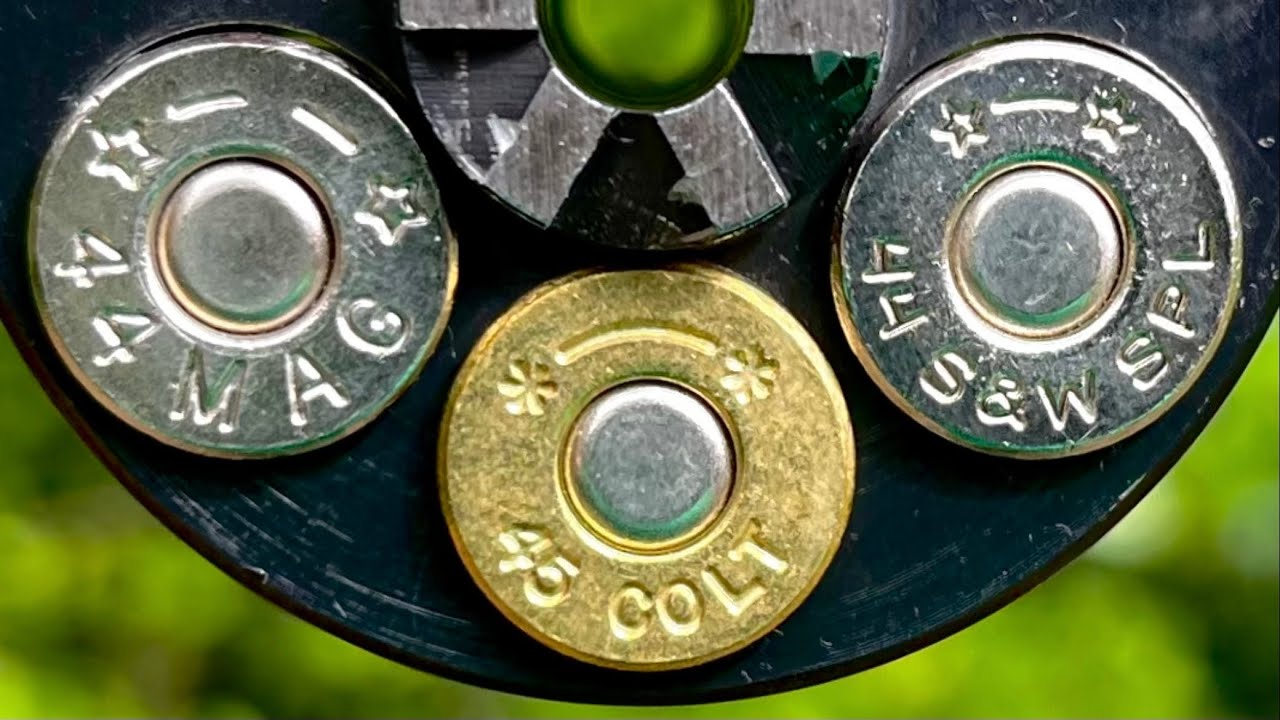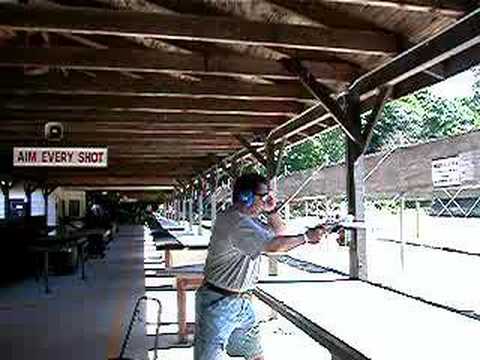Originally published at: THE .44 MAGNUM SIXGUN - Sixguns Firearm Fraternity
The .44 Magnum is now well into its fifth decade and it seems good to
look back at the history of this excellent, even all-around sixgun load
and some of the fine guns that have been made and are still being made
for the big forty-four.
If you are not a reader of Elmer Keith I would suggest that you become
one. It is impossible to discuss the .44 Magnum without him. For much of
his life Elmer was way ahead of his time. His books on sixguns, SIXGUN
CARTRIDGES & LOADS (1936) and SIXGUNS (1955, 2nd Edition 1961) are
still viable and still make good reading. His features and columns in AMERICAN
RIFLEMAN in the 1920’s through the 1950’s, and GUNS and GUNS & AMMO
from the 1950’S until the time of his stroke in 1981, still make fascinating
reading. As Keith closed his book SIXGUNS in 1955, he said: "We desperately
need a modern up-to-date, full-powered factory loaded .44 Special–the
King of all Handgun Cartridges." Keith was right, but it would not
be his .44 Special load but a totally new cartridge.
For thirty years Keith had been writing about his heavy handloads used
in .44 Special sixguns, namely Smith & Wesson TripleLocks, and Model
1926 Targets, and in Colt Single Actions. His standard load was 18.5 grains
of #2400 and his 250 grain Lyman #429421 bullet loaded over standard primers
in balloon head cases. This load was changed to 17.0 grains of #2400
with the advent of modern solid head brass. Both loads give around 1200
feet per second from seven and one-half inch barreled sixguns.
For those same thirty years Keith had been trying to convince ammunition
manufacturers to bring out his 250 grain/1200 feet per second .44 Special
load but to no avail. Product liability is nothing new and they were afraid
that someone would blow an old .44 Special apart. Elmer claimed there would
be no problem with any Colt or S&W heavy frame sixgun, as he had been
shooting this load in pre- World War II sixguns for years. It was my good
fortune to inspect and unload many of Elmer’s sixguns after his death in
1984. I was able to lovingly fondle all the sixguns we had seen in pictures
in magazine articles and books for so many years. None of the .44 Special
TripleLocks, Model 1926’s, Model 1950’s, or Colt Single Actions showed
any evidence of `shooting loose" by any means.
One person that did listen to Keith was Carl Hellstrom, president of
S&W in the 1950’s. He showed interest in Elmer’s pet load and discussed
the prospect of a new forty-four sixgun with him. Who would supply the
ammunition? Only with the dawn of silhouetting and the explosion of handgun
hunting would we see firearms being produced without factory ammunition
available. Hellstrom went to Remington and they agreed to supply the ammo
if Smith & Wesson would supply the sixgun. Remington produced the first
lot of ammunition in 1954. The new ammunition was one-eighth inch longer
than the .44 Special, and this was done so it would not chamber in .44
Special sixguns. This had to be done since this was not Elmer’s .44 Special
load but truly a full-house big bore Magnum load. Please note carefully:
Keith did not invent the .44 Magnum as others have stated. He simply lead
the way with his .44 Special load and the ink he gave it for so many years.
Smith rechambered four 1950 Target .44 Specials for the new round in
1954. These were standard .44 Specials except for the rechambering and
specially heat treated cylinders. Remington received one of the "new"
revolvers for testing and it was soon obvious that the thirty-nine ounce
weight of the .44 Target Model was definitely too light for the recoil
of the new .44 Special Magnum. Keith had asked for 1200 feet per second
and the new round was claimed to achieve 1500 feet per second plus!
To provide the desirable increase in weight, S&W introduced a sixgun
with a barrel that was .15" greater in diameter and a cylinder that
was .18" longer. This brought the weight of the six and one-half inch
barreled original .44 Magnum up to three pounds. Strangely enough, thirty-five
years later, a "new" .44 Magnum Mountain Pistol would be offered
with a .44 Special barrel!
By early 1955, tests were completed and Smith & Wesson began tooling
up to produce what at the time was known simply as the .44 Magnum. The
first factory revolver was completed on December 29, 1955 and shipped to
Remington. In January, the next two were completed and one went to the
NRA for testing by Major Hatcher and the other was shipped to Elmer Keith
in Salmon, Idaho. By the end of 1956 more than 3000 Smith & Wesson
.44 Magnums had been produced in the original six and one-half inch length
as well as the easy packin’ four-inch length. The eight and three-eighths
inch length would follow in 1958.
As a kid fresh out of high school, I fired one of the first four- inch
.44 sixguns that a local dealer rented out at six shots for fifty cents.
It was a real attention getter at his range and it certainly got my attention.
I fired it and said the recoil wasn’t bad. I lied!
Reporting in the AMERICAN RIFLEMAN for March of 1956, Major Hatcher
said: "In shooting the .44 Magnum, we found it advisable to use gloves,
as the recoil can only be described as severe. Without gloves, the checkering
hurts the hand, and the sharp edges of the cylinder latch are almost certain
to shave off bits of skin. After firing many heavy handloads in the .44
Special, we expected a heavy recoil with this ultra-powerful new cartridge.
At the first shot the gun rose up a bit, and the first reaction was that
it was not as bad as we had expected. Just about that time, however, we
suddenly experienced a sharp stinging sensation over the entire hand, as
though we were hitting a fast baseball with a cracked bat. I fired quite
a few shots with this gun, but I must honestly confess it is not an unmixed
pleasure."
Keith writing in the GUN DIGEST looked upon the .44 Magnum quite differently
than Major Hatcher. After all it was his baby. "The big gun is, I
would say, pleasant to shoot, and does not jar the hand as much as do my
heavy .44 Special loads from the much lighter four-inch barreled .44 Special
S&W guns. It is definitely not a ladies gun but I have known women
who would enjoy shooting it. The recoil has not bothered me in the slightest,
nor have several old sixgun men complained who have fired it extensively,
including Hank Benson and Don Martin. The recoil is not as severe as that
of a two-inch Airweight Chief’s Special with high speed .38 Specials. With
.44 Special factory loads it is just as pleasant to shoot as a K-22 and
with the .44 Magnum loads, which give the highest recoil, it will not bother
a seasoned sixgun man at all. Recoil with my heaviest loads of 22 grains
of 2400 and the Keith 250 grain bullet is much less than that of the factory
load. The factory load, fired with one hand, flips the barrel up almost
to the vertical."
I’m afraid Keith’s assessment sold many .44 Magnum sixguns which then
wound up back on the dealer’s shelves as slightly used guns since the shooter
found that their reaction upon shooting the .44 was much closer to Major
Hatcher’s.
By 1957, Ruger’s offering in .44 Magnum was starting to show up on gun
dealer’s shelves. At first they had rechambered their .357 Blackhawk, which
was smaller than today’s .357 New Model Blackhawk, to .44 Magnum. Three
of these were shown at the NRA Convention, with barrel lengths of four
and five-eighths inches, five and one-half inches, and seven and one-half
inches. Elmer relates: "They were very nice looking sixguns, but the
cylinder was too short to accept my .44 Magnum handload, and I told him
(Bill Ruger) then the frame was too small and the cylinder also too small
in diameter for the heavy load. Bill asked me if I wanted one and I told
him I would like the four and five-eighths inch and would use it with .44
Special loads. He told me to pick it up before leaving for Idaho, but when
I went to get it the boys had packed it for shipment back to the Ruger
factory; so Bill said he would send it to me. However, before shipping,
he decided to proof fire it, during which time the gun blew up. Bill then
wrote that I was right and he was redesigning the whole gun to handle the
big load. The frame would be made larger and also the cylinder, and it
would be longer to handle perfectly my 250 grain .44 Magnum handload. He
sent me one in the so- called Black Hawk design in four and five-eighths
inch barrel. It proved to be very fine single action but I was still not
satisfied."
Keith than goes on to relate the improvements he asked for which resulted
in the Super Blackhawk two years later. For myself, I much prefer the original
.44 Blackhawk, now lovingly known as the Flat-Top, to the `improved’ Super
Blackhawk. The original was much lighter and had the Colt Single Action-style
grip frame that I still prefer over the Dragoon style Super Blackhawk grip
frame that Colt dropped in 1851!
The first prototype Ruger .44 Magnums on the .357 frame were in the
standard Colt Single Action barrel lengths but for some strange reason
when the .44 Blackhawk became a reality the barrel length was six and one-half
inches. I much prefer the balance of seven and one-half inch length .44
Blackhawk and had my first year six and one-half inch Blackhawk first cut
to four and five-eighths inches and then later rebarreled to seven and
one-half inches with an early Super Blackhawk barrel.
For some reason the original Blackhawk was never offered with the shorter
easier packin’ four and five-eighths inch length that was made up for Keith
or the five and one-half inch length. Of the nearly 30,000 .44 Magnum Blackhawks
produced, around 1,000 each were made in seven and one-half inch and ten-inch
lengths and all the rest were six and one- half inchers.
In 1959, the Super Blackhawk was introduced and the standard .44 Blackhawk
was finally dropped in 1963 when Ruger went to the Three-Screw or Old Model
frame and grip frame. The Three Screw Ruger Super Blackhawks were offered
only in seven and one-half inches in length except for a very few that
were one inch shorter. With the coming of the New Model Super Blackhawk,
ten and one-half inch models were offered for silhouetting and hunting
and just recently Super Blackhawks have been available with shorter barrels
and standard Blackhawk grip frames.
By 1958, .44 Magnums were available from not only Ruger and Smith &
Wesson, but Great Western as well. The Great Western did not last long
as the Great Western factory folded and the only .44 Magnums available
in the 1960’s were the Smith & Wesson .44 Magnum and the Ruger Super
Blackhawk.
Enter Detective Harry Callahan. Clint Eastwood’s unrealistic portrayal
of a San Francisco cop who carried a .44 "Go ahead, Make my day!"
Magnum created such a demand that Smith & Wessons soon doubled in price.
In a way this false demand turned out to be a good thing as other manufacturers
tried to get in on the .44 Magnum craze and we have since seen forty-fours
from Freedom Arms, Texas Longhorn Arms, Dan Wesson, InterArms, Mossberg,
U.S. Arms, High Standard, Iver Johnson, Arminius, Llama, Astra, R.G., F.I.E.,
and Sauer.
Two prototypes that never saw production are very interesting. The first
is a .44 Magnum TripleLock from Rossi of Brazil. This was a very good looking
four-inch .44 Magnum with a vent rib barrel and a cylinder that locked
fore, aft, and also at the front of the cylinder. This sixgun also had
smooth wood stocks that looked much like the Skeeter Skelton style now
offered by BluMagnum. Whoever designed this .44 understood sixguns. Where
is it now?
The second protype was a beefed up Colt Single Action in.44 Magnum that
never saw production. It looked much like the later Abilenes, El Dorados,
and Sevilles. Finally after thirty-five plus years Colt offered a .44 Magnum
in the excellent Anaconda.
The .44 Magnum is no longer the World’s Most Powerful revolver. It has
been overtaken by both the .454 Casull and the .445 SuperMag as well as
the wildcat .475 and .500 Linebaughs. But for most shooters, the .44 is
plenty gun, and perhaps even more than they bargained for. The forty- four
has been around for nearly forty-five years and I can’t see anything in
the future except more popularity for this excellent cartridge and the
fine sixguns made for it. As we are in the closing days of the twentieth
century, I think it will be safe to say that the .44 Magnum will be regarded
by most sixgunners as the premier cartridge development of the last 100
years. It has been king for nearly fifty years to which we simply say:
"Long Live The King!"


